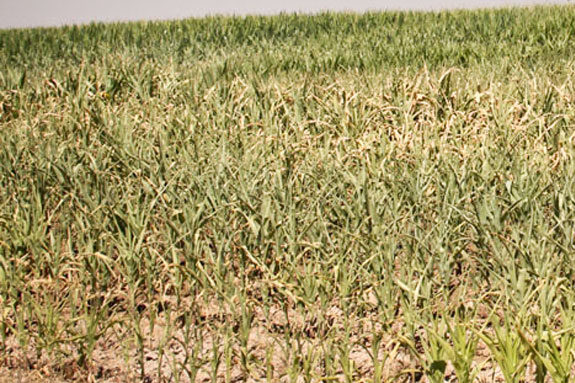This is especially true considering corn occupies more irrigated acres than any other crop in the semiarid Great Plains region.
To maximize yields and economic returns when faced with limited water supplies, growers should focus on irrigation management practices, agronomic management practices, hybrid selection and plant populations.
Irrigation management practicesIn areas of limited water availability, proper irrigation management can maximize water use efficiency.
Corn yields respond in a linear fashion to increasing evapotranspiration (ET) until full seasonal ET requirements have been met. Applying additional irrigation beyond this results in diminishing returns on water and does not increase grain yield as much as the previous inch of irrigation.
When water allocation cannot meet full crop ET, save enough allocation to minimize water stress during the reproductive stages, where it will have the most impact. In addition, in extremely dry years, pre-irrigation may be needed to refill the soil profile.
Agronomic management practices
From an agronomic perspective, maximize the efficiency of storage of all water inputs into the cropping system. This includes both precipitation and irrigation water.
Residue and tillage management also can impact the increasing availability of water. Many growers in the Great Plains regions have used ecofallow and no-till systems that enable corn to maximize yields under limited water availability.
Planting corn directly into standing residue, such as wheat, under no-till conditions increases the amount of water stored in the soil due to improved infiltration, reduced evaporation from tillage operations, reduced runoff and increased snow catch.
These same techniques can be used successfully under limited water conditions.
Hybrid selection
When selecting an appropriate hybrid for limited irrigation situations, consider two primary characteristics – hybrid maturity and drought tolerance ratings.
Hybrid maturity can have a big impact on corn water requirements. Full-season hybrids use more water than short-season hybrids, but also produce more grain if the heat units and water are available. However, the grain produced for each inch of ET is approximately equal. Thus growers should choose a hybrid maturity that matches their seasonal water supply.
Pioneer has been focused on drought research efforts specifically related to drought tolerance since the opening of its York, Nebraska, research center in 1958. Since that time, Pioneer has conducted studies comparing historical and modern hybrids for performance under water-limited conditions.
This research has shown that grain produced per inch of water improved from about three bushels per acre per inch of water for hybrids from the 1930s and 1940s to nearly 10 bushels per acre per inch of water for hybrids from the 1990s.
Drought tolerance is a complex quantitative issue controlled by a large number of genes and is influenced heavily by environmental factors (for example, heat, water stress, soil types). Through smart hybrid selection, growers not only can address drought and irrigation issues, but also help minimize risk and maximize productivity and profitability on every acre.
Plant populations
It also is important to select the right population for planting. Suggested populations for limited irrigation production usually are less than that for fully irrigated production.
Populations generally are lowered to reduce the transpiration component of ET by the crop and better match precipitation, stored soil moisture and irrigation water supplies to crop requirements.
In the end, managing corn with limited water availability comes down to solid irrigation management practices, agronomic management practices, hybrid selection and plant population decisions. All of these factors can improve not only water use efficiency, but ultimately yield and economic outcomes for growers.
When considering these factors, it’s also important to remember that drought management requires specific and local management considerations. Be sure to work with your local agronomy experts to implement the water-limited management practices that are best for your fields and your unique situation. FG

Bill Ramsey
Western Livestock Information Manager
Pioneer Hi-Bred
PHOTO:
Drought tolerance is a complex quantitative issue controlled by a large number of genes and is influenced heavily by environmental factors (for example, heat, water stress, soil types). Photos courtesy of Patti Bennett.











